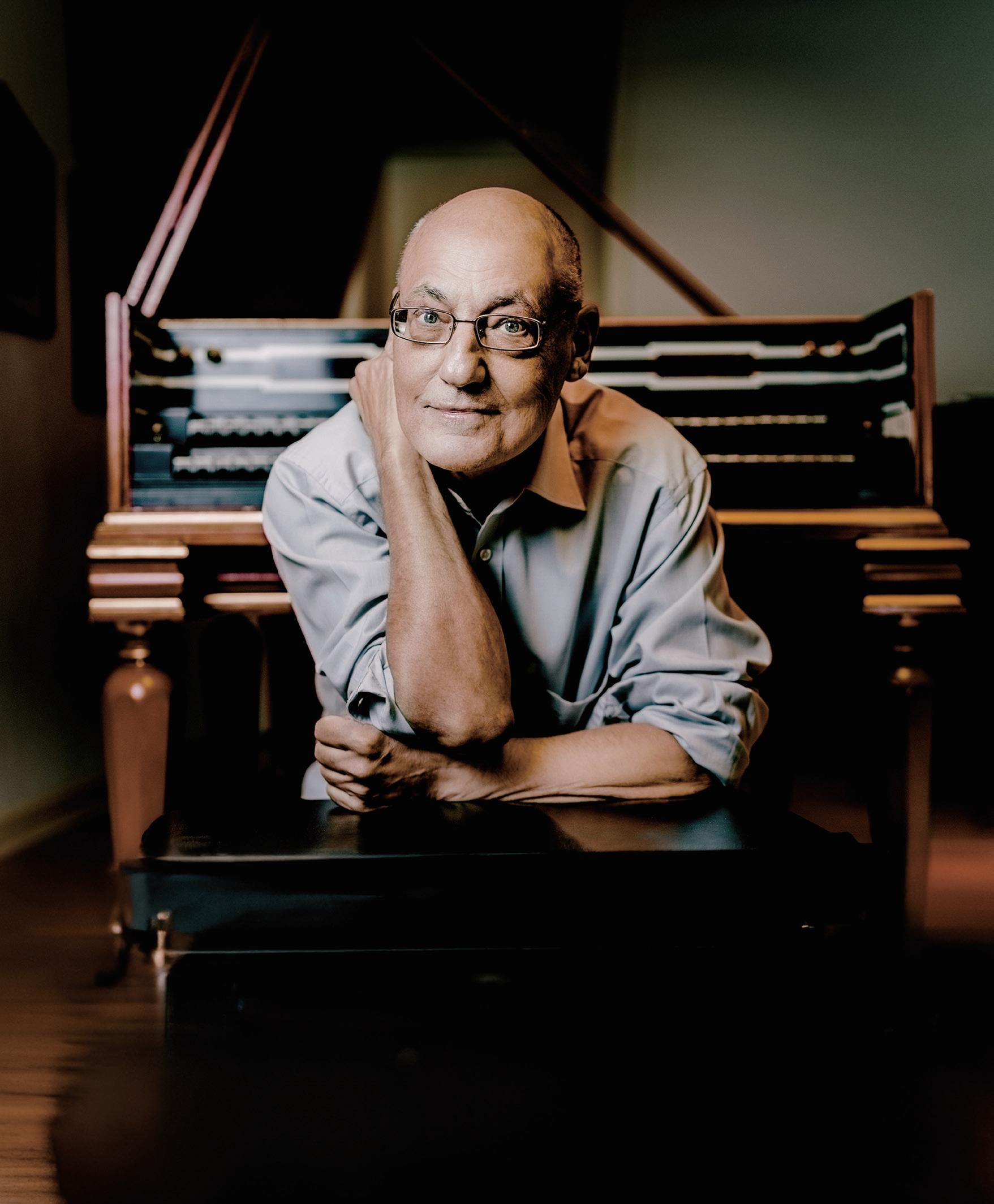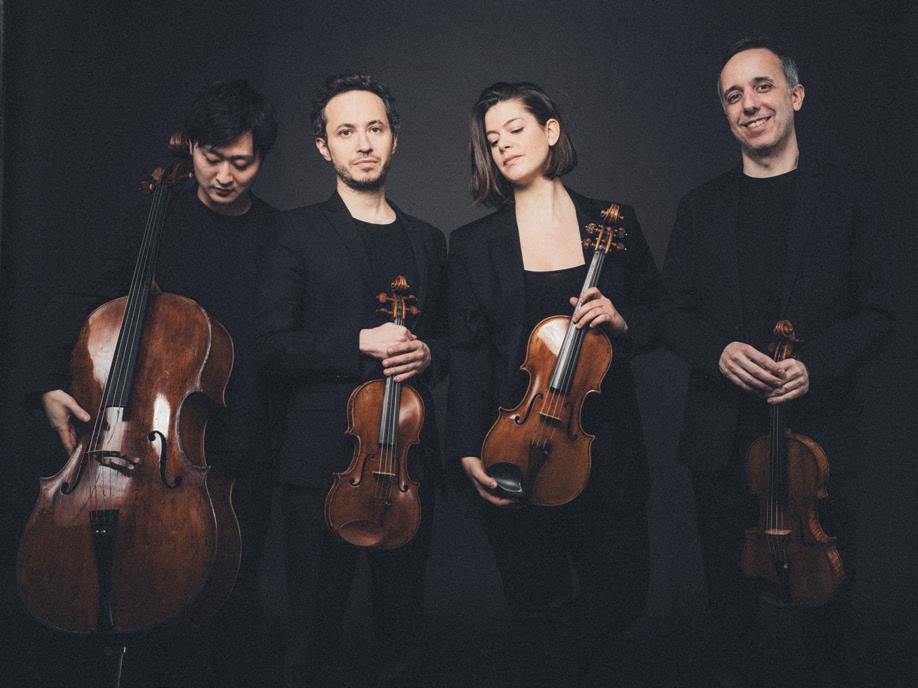Welcome to the Grand Hall
Thank you for coming to this HKU MUSE event. To ensure that everyone enjoys the music, please switch off your mobile phones and any other sound and light emitting devices before the performance. Unauthorised photography and audio/video recordings in the Hall are prohibited. Enjoy the concert and come again.
Presented by
Supported by
Follow us
18 OCT 2024|FRI|8PM
Grand Hall, The University of Hong Kong
Andreas Staier, harpsichord
J.C.F FISCHER Prelude and Fugue in E major from Ariadne musica
FUX Fugue from Gradus ad Parnassum
J.C.F FISCHER Prelude and Fugue in C-sharp minor from Ariadne musica
L. COUPERIN Pavane in F-sharp minor
J.C.F FISCHER Prelude and Fugue in D major from Ariadne musica
FROBERGER Ricercar IV
J.C.F FISCHER Prelude and Fugue in A major from Ariadne musica
FROBERGER Méditation sur ma mort future
Allemande
Courante
Sarabande
Gigue
FROBERGER Fantasia II - INTERMISSION -
ANDREAS STAIER
Anklänge, Six Pieces for Harpsichord
Tempo flessibile
Largo
Con forza
Un poco più lento del Preludio BWV 878/1
Sempre legatissimo
Esitando
J.S. BACH
Prelude and Fugue in E major, BWV 878 from the Well-Tempered Clavier, Book II
ANDREAS STAIER
harpsichord

The pianist Andreas Staier first became world famous as a harpsichordist. After studying with Lajos Rovatkay and Ton Koopman, he worked for three years with the Musica Antiqua Köln. But Staier is far more than a virtuoso representative of so-called historical performance practice. Rather, one could describe him as a passionate sound seeker. Each work that the pianist undertakes is not only analysed in terms of its structure, but also explores the historical situation in which it originated. Through his meticulous approach, he has opened up completely new interpretive approaches and made surprising listening experiences possible. This is why he also works with instrument makers to explore special nuances of sound—be it works of the 16th century such as the English virginalists, Bach's Goldberg Variations , the Diabelli Variations of the late Beethoven or the last piano works by Brahms. Staier has also always turned to lesser known composers when he could discover original aspects in their works, such as Sebastián de Albero or Josef Antonín Štěpán.
His commitment does not end with the music of the 19th century. This is shown by Staier's collaboration with the French composer Brice Pauset (b. 1965) from whom several compositions have been commissioned. The Kontra Sonata (2000), a hybrid of Schubert's Sonata in A minor, D. 845 and Pauset's Kontrakompositionen is a prime example of Staier's epochcrossing musical thinking. Staier himself used the time during the Corona
Pandemic to finish his composition Sechs Cembalostücke which he puts in connection with Bach's Prelude and Fugue in E major of the Well-Tempered Clavier Book II. The work was premiered at the Philharmonie in Cologne in January 2023 and the accompanying album Méditation was released in 2024 by Alpha Classics (Outhere Music). The sheet music is published by Editions Lemoine.
All this is documented on numerous recordings, almost all of which have received prestigious awards. Staier himself has often been honoured for his work: In 2024 he was awarded the prestigious Bach Medal of the City of Leipzig. He was Artist in Residence at the AMUZ in Antwerp from 20122016, and between 2011 and 2021 at the Opéra de Dijon.
Both on harpsichord and on fortepiano, Staier performs at numerous renowned music festivals worldwide with ensembles such as the Freiburger Barockorchester, Concerto Köln, the Akademie für Alte Musik Berlin, and the Orquestra Barroca Casa da Música Porto with which he recorded À Portuguesa with works by Spanish composers for harmonia mundi in October 2018. For the Beethoven jubilee, Staier presented his album Ein neuer Weg—Beethoven, based on the three Op. 31 piano sonatas and the variations Opp. 34 and 35, which received rave reviews. His recording of the Well-Tempered Clavier Book II is considered a reference recording. With the release of Book I in 2023, the publication of his work was completed. Together with Roel Dieltiens he also released Beethoven's Cello Sonatas, Op. 102 and the Bagatelles Opp. 119 & 126.
Longtime musical partners include the pianists Alexander Melnikov, Christine Schornsheim, Tobias Koch, the violinists Isabelle Faust and Petra Müllejans, and the tenor Christoph Prégardien. Andreas Staier maintains a close collaboration with Daniel Sepec and the cellist Roel Dieltiens, with whom he has released an album of the Schubert piano trios amongst others.
Staier's extensive interests and abilities have made him a much soughtafter educator from an early age. In addition to masterclasses worldwide, he was Professor of Harpsichord and Fortepiano at the Schola Cantorum Basiliensis from 1987-1995. During the 2017/18 season, Andreas Staier was a Fellow at the Wissenschaftskolleg zu Berlin.
For several years, Andreas Staier also has been performing as a conductor and orchestra leader.
MÉDITATION
ANDREAS STAIER
Music is often written about music. Certain themes and problems cannot be resolved swiftly and as a result continue through several generations. Two motifs in particular form a thread that runs through most of the works presented on this recording.
The first of these motives is an ancient cantus firmus that also establishes the structural framework of this programme. The fugues in E major by Johann Caspar Ferdinand Fischer and Johann Sebastian Bach make clear use of this theme—the second line of the Communion hymn Pange lingua (c. 1264) attributed to Thomas Aquinas—at their beginning and end. This sequence of notes—in E major E-F -A-G -F -E—would be taken up and reworked again and again over the centuries. Famous examples of this include not only the Christe eleison from Josquin's Missa Pange lingua (c. 1515), but also the finale of Mozart's 'Jupiter' Symphony (1788); in the latter work the cantus firmus is concentrated into the first four notes of the theme and is transposed into C major: C-D-F-E.
Three more of the works recorded here make use of this theme: Johann Jakob Froberger's Ricercar IV (in G—Mixolydian mode), the same composer's Fantasia II (in E—Phrygian mode), and a short example (also in E—Phrygian mode) from Johann Joseph Fux's famous counterpoint treatise Gradus ad Parnassum (1725). No other cantus firmus in Fux's treatise has been performed in nearly as many arrangements as this Pange lingua. The short movement played here is the last of Fux's versions.
Bach is the vanishing point of this programme, which immediately begs the question as to which of the various arrangements of the Pange lingua presented here were known to him. In a letter from Carl Philipp Emanuel Bach to Johann Nikolaus Forkel, J.S. Bach's first biographer, we read that the very young Bach had "loved and studied" Froberger's works alongside works by many other composers, although we do not know which ones in particular; it is impossible to deduce whether Bach knew Froberger's Ricercar IV and Fantasia II or not. We can, however, be sure that Bach was extremely familiar with Fischer's Ariadne musica , a collection of preludes and fugues in 19 of the 24 major and minor keys arranged in ascending chromatic order, for it clearly was one of Bach's most important sources of inspiration as he prepared to compose the Well-Tempered Clavier . He also paid his respects to Fischer by incorporating two of the latter's fugue
themes untransposed and almost verbatim into the Well-Tempered Clavier: the fugue theme in F major into the first book and the one in E major into the second.
Fux's example of counterpoint leads us into the direct intellectual context of Bach's Fugue in E major. Fux's Gradus ad Parnassum , written during the 18th century, was for long the most influential textbook of counterpoint available. It deals with the stile antico, the style of Italian vocal polyphony of the late Renaissance; this was displayed in its purest form in the works of Giovanni Pierluigi Palestrina (1525-1595), whose masses and motets were considered the ideal of Catholic church music for several centuries. Bach's Fugue in E major was probably composed in the late 1730s and is the purest example of the stile antico to be found in his entire body of work. Bach's exploration of this style must surely be seen in connection with his decision at more or less the same time to set the remaining sections of the Mass in addition to the Kyrie and Gloria that he had already composed in 1733, creating a Missa tota that would later become known as the Mass in B minor. This was the moment of Bach's (renewed?) preoccupation with the Gradus ad Parnassum . At this time Bach also befriended the young philosophy and music student Lorenz Mizler, whom—as Christoph Wolff plausibly suspects—Bach encouraged to translate the Latin text of the Gradus ad Parnassum into German.
As has already been mentioned, it was not unusual in Bach's time for composers to use fugue themes by other hands—here Bach adopted themes by Fischer and Fux. Many such themes were considered to be common knowledge and were worked out in a spirit of contrapuntal competition by several composers in succession, who often made explicit references to each other's work. The more improvisatory genre of the prelude, on the other hand, is far removed from such learned references; because of this, it is unusual that the prelude of Bach's two movements in E major also shows motivic and atmospheric affinities with Fischer's prelude in the same key. Fischer's opening gesture is shaped around the notes E-B-C -G . These same four notes, with the first E transposed one octave lower, form the beginning of Bach's prelude.
This sequence of intervals—octave, fifth, sixth and third—forms the second leitmotif of this programme; it has been ubiquitous in music at least since
the early Baroque era. Here it forms the theme of Fischer's Prelude in A major and plays an important expressive role in two great laments: the Pavane in F-sharp minor by Louis Couperin and the Méditaton sur ma mort future by Froberger. Not only does Beethoven use the same sequence of notes to launch his sonata for cello and piano in A major, but the bells in Wagner's Parsifal also sound the same intervals.
Anklänge ..., my six pieces for harpsichord, emerged from conversations I had with the composer Brice Pauset; we exchanged views time and again about what it means to compose at this point in history, about its significance and in particular what the implications of composing for historical instruments might be.
This led me to the question: given that my own concept of music has been influenced not only by Byrd, Bach, and Schubert but also by the music of the 20th and 21st centuries, how could I best express and realise this in notational form? The fruit of this reflection was a wide variety of sketches, most of which were begun during holidays but were left unfinished when daily life resumed. The enforced paralysis of concert life in 2020 did, however, give me the time to sift through all my loose pages and notes: finished compositions finally emerged that I had initially never foreseen as such when I had begun them.
These pieces are based on six chords
which also conceal the two cantus firmi mentioned above. The complete Pange lingua theme, in different transpositions, is contained in the first, third and sixth chords, with its first three notes forming the largest factor common to all six chords; the Parsifal motif is contained within the sixth chord. Combinations of notes then unconcernedly arise that can be heard as memories or echoes of certain moments from J.S. Bach's Prelude and Fugue in E major from the second part of the Well-Tempered Clavier.
Structural elements from this work influence my compositions on different levels. Some concern the organisation of time or affect combinations and permutations of pitches; they can remain almost inaudible on the surface, as in the second piece, which relates Bach's fugue theme to various aspects of the six chords mentioned. It is only in the fourth piece that windows are opened to allow short sequences of notes—here from Bach's Prelude, albeit in a reversed temporal direction—to become audible.
The first, third, and fifth pieces are based on canonic techniques. The first works with a chord progression—quadrupled by permutation and transposition—which is performed in canon at four different speeds. The third consists of inversion canons with ascending axes of symmetry, whilst the fifth—analogous to the fifth chord of the moment of greatest reduction— is a kind of crab canon. To conclude, the last piece may be considered a kind of personal diary, even as a declaration of love for Bach. My intention is that Bach's Prelude and Fugue should follow these pieces without pause.
My warmest thanks go to Isabel Mundry. Once these pieces were complete she spent many hours in discussing various aspects of my works with me. I am indebted to her for a wealth of valuable advice.
© Andreas Staier
English translation © Peter Lockwood Reprinted by the kind permission of Alpha Classics, Paris













































